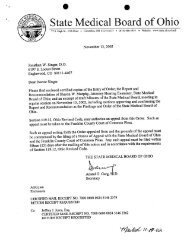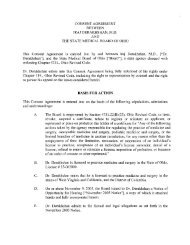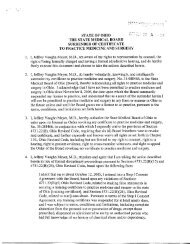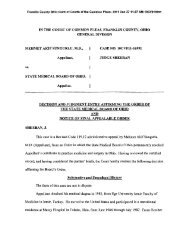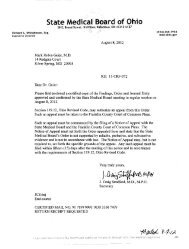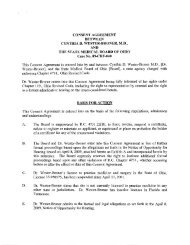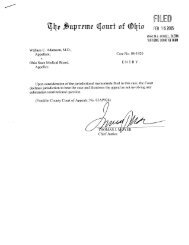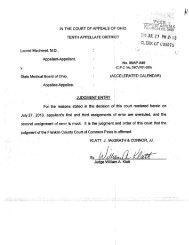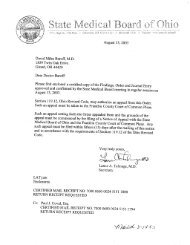CONSENT AGREEMENT BETWEEN - State Medical Board of Ohio ...
CONSENT AGREEMENT BETWEEN - State Medical Board of Ohio ...
CONSENT AGREEMENT BETWEEN - State Medical Board of Ohio ...
You also want an ePaper? Increase the reach of your titles
YUMPU automatically turns print PDFs into web optimized ePapers that Google loves.
Matter <strong>of</strong> Kyle Elliott Hoogendoorn, D.P.M. Page 36<br />
Dr. Bressi further testified that he had reviewed the list <strong>of</strong> medications contained in the<br />
<strong>Board</strong>’s notice letters to Dr. Leak, Dr. Griffin, and Dr. Hoogendoorn. Dr. Bressi testified<br />
that he did not find that any <strong>of</strong> those medications would have been inappropriate for<br />
Dr. Hoogendoorn to have prescribed under the supervision <strong>of</strong> Dr. Leak or Dr. Griffin in the<br />
context <strong>of</strong> Dr. Hoogendoorn’s fellowship. (Tr. at 2482-2486)<br />
Testimony <strong>of</strong> Dr. Leak<br />
79. With regard to the supervision Dr. Hoogendoorn received when he wrote prescriptions for<br />
non-podiatric conditions, Dr. Leak testified:<br />
Dr. Hoogendoorn would present a patient and make recommendations. That’s<br />
the nature <strong>of</strong> training. If the attending makes all the decisions, there is very<br />
little hope that the trainee will absorb much <strong>of</strong> anything. So they—he would<br />
present and, if supported by the attending, those were the prescriptions that<br />
were written.<br />
(Tr. at 448-449)<br />
Dr. Leak further testified that Dr. Hoogendoorn had received training concerning the<br />
medications he prescribed and how they affected the body. (Tr. at 449)<br />
Testimony <strong>of</strong> Dr. Griffin<br />
80. With regard to Dr. Hoogendoorn’s issuance <strong>of</strong> prescriptions for non-podiatric conditions,<br />
Dr. Griffin testified: “The patient would come into the clinic. The nursing staff would do<br />
vital signs, put them in a room. If [Dr. Hoogendoorn] saw the patient, he would go see the<br />
patient, do a history and physical, form a treatment plan, which included medications on<br />
occasion. And then he would bring it to me.” Dr. Griffin would then examine the patient<br />
and, if he agreed with Dr. Hoogendoorn’s treatment plan and choice <strong>of</strong> medication, he<br />
would approve the prescription(s) that Dr. Hoogendoorn had suggested. Dr. Griffin<br />
testified that Dr. Hoogendoorn had not issued prescriptions for non-podiatric conditions<br />
until Dr. Griffin or Dr. Leak had had a chance to examine the patient and determine<br />
whether the prescription was acceptable, and that, if a prescription “made it out <strong>of</strong> the<br />
building,” either Dr. Leak or Dr. Griffin had approved it. (Tr. at 676, 807-809)<br />
81. Dr. Griffin testified that, for a short time Dr. Hoogendoorn had issued prescriptions under<br />
his own name, after the prescriptions had been approved by Dr. Griffin or Dr. Leak.<br />
Dr. Griffin further testified that, after about two weeks, during a regular meeting at PCC,<br />
Dr. Leak and Dr. Griffin determined they would rather issue the prescriptions under their<br />
names “because certainly we were responsible anyway[.]” (Tr. at 3051-3053)



